This is the last Sunny sold under the “Datsun” brand in Japan. The final rear-wheel-drive Sunny from model year 1978 to 1982 featured numerous variants, including a fastback station wagon as well as more squared-off, utilitarian models with three and five doors, a coupe, and two- and four-door sedans. They were first introduced in October 1977, going on sale on 21 November
in Japan.
At home they only received the new A12A engine and the slightly larger A14, although the Van continued to receive the earlier, smaller, A12 engine. The “Excellent” trim package was discontinued as the top level model, and the B211 van continued to be built for a little while longer. In Japan on February 1978 the Sunny Coupe 1400SGX-E and the 1400GX-E appeared, as a replacement for the previous Sunny Excellent Coupe. The “E” denotes multiport fuel injection, an option offered only in Japan.
This generation was also the last utilizing front engine and rear-wheel drive powertrains.
These models appeared with Datsun 120Y, 130Y, 140Y and 150Y badges in some markets (reflecting the engine size) though Sunny was increasingly used for export, too. The North American version was marketed as the Datsun 210. The B310 was known for its high equipment levels and build quality at the time. It was available with the same A-series engines as its predecessor although the B210’s optional 63-series five-speed transmission was replaced with the more compact and lighter 60-series unit, with a standard gear pattern.[28] On all body variants except the Van and “squareback” wagon, the leaf spring rear suspension
was replaced by a more advanced coil spring four-link configuration, while the front had struts with coilover springs.Other than that, the chassis was very similar to that of the B210, albeit with a beefier front suspension and a relocated fuel tank in the sedans. It was now beneath the floor of the trunk, freeing up more space for luggage.The body was designed to provide fewer moisture traps, helping protect the car against rust, while added width meant additional space, particularly for the rear seat passengers.
In 1980, the B310 was given a mild facelift, with a smoothed off front end, a grille with square headlamps, and a redesigned dashboard. In November 1980 the A12A and A14 engines were replaced by the marginally larger A13 and A15 versions in the Japanese markets. At the end of 1981 passenger car versions of the B310 were replaced by the front-wheel drive B11 Sunny, although the Vans continued to be built for a few more years.
In North America, the only wagon offered was the fastback version. In Japan, this fastback wagon was a special model called the Sunny California, aimed at private buyers unlike the square-backed 3-and 5-door Sunny Van (although for the Japanese market these vans were always fully glazed and usually had a back seat) meant for the long-standing Japanese commercial wagon market. In most other markets the more traditional two-box wagon was offered, either alone or alongside the fastback, and some countries where “no rear side glass” was part of a legal definition of a “light truck” got panelled-in versions of the three-door. The van versions also differed in that they retained the leaf spring suspension from the B210, and in most markets had a more spartan interior trim with vinyl covered seats. The five-door van was discontinued in November 1982 when the new and even boxier Nissan AD range was introduced. In July 1983 this appeared in a three-door version, meaning that the VB310 was retired.
This model marked the first and only time the “Sunny” name was used in Australia. This chassis, along with the A10 chassis on the 160J/Violet/Stanza formed the basis for the S110 chassis on the Nissan Silvia.
In most markets, the A12 engine was the only, or most common engine offered. However B310s in various markets were fitted with the following A-series engines (power outputs for the Japanese market unless otherwise specified):
A12 (1171 cc), 68 PS (50 kW) at 6000 rpm, 52 PS (38 kW) (Europe)
A12A (1237 cc), 70 PS (51 kW) at 6000 rpm
A13, (Short Deck Engine)
A14, 80 PS (59 kW) at 6000 rpm, 63 PS (46 kW) (Europe)
A14E, fuel injection and 92 PS (68 kW) at 6400 rpm
A15 (from late 1980), 70 PS (51 kW) (Europe)
Datsun 210 (1979-82)
In North America, the Datsun 210 engine line ups were as follows:
1979 – A12A (late introduction) or A14
1980–1982 – A12A, A14 or A15
The 210 was available in North America as a two- or four-door sedan, a five-door wagon (the sloping fastback style), or as a three-door hatchback coupe. At the time of introduction all models, excepting the wagon with the automatic transmission, received the carryover 1.4 liter A14 engine with 65 hp (48 kW). The automatic wagon (soon all wagons) received the somewhat larger A15 engine with 67 hp (50 kW).
New for 1981, the special “210 MPG” model was a small-port A14 with five-speed overdrive transmission and achieved 40 mpg US (5.9 L/100 km; 48 mpg imp) per US standards. For 1981, this was the only 1.4 available. All other versions excepting the standard 1.2 received the larger 1.5. Even the most powerful 1.5-litre option produced only 65 hp (48 kW; 66 PS), being strangled by the required desmogging equipment. The smallest 1.2 was only available as a four-speed, two-door sedan with very basic equipment. It was also assembled by AMI in Australia under license
YLN 302/303
In Taiwan, Yue Loong continued building the B310 series until the 1990s as a lower priced alternative to more modern Sunnys. Originally introduced as the YLN 302, with SD or DX equipment (Standard, DeLuxe)[25] it underwent a facelift in 1981 in parallel with Nissan’s Sunny, becoming the YLN 303. After another facelift (in 1989), it became the YLN 303S. The station wagon was also offered in Taiwan, as the YLN 303W. The Yue Loong-built B310s were only ever available with the 1.2-litre A12 engine.
Overview
Chassis Codes B210, WB310. KB310, VB310
Manufacturer NissanAlso called Datsun Sunny, Datsun 210, Datsun 120Y/130Y/140Y/150Y, Yue Loong 302/303Production
November 1977 – November 1981
Assembly Zama Plant, Zama, Kanagawa, Japan
Body and chassis
Body style
2/4-door sedan
3-door coupe
3/5-door wagon/van
5-door wagon (fastback)
3-door panel van
Layout
Front-engine, rear-wheel-drive
Powertrain
Engine
1171 cc A12 I4 OHV (In Line 4 Cylinder)
1237 cc A12A I4 OHV (In Line 4 Cylinder)
1270 cc A13 I4 OHV (In Line 4 Cylinder)
1397 cc A14 I4 OHV (In Line 4 Cylinder)
1487 cc A15 I4 OHV (In Line 4 Cylinder)
Transmission
4- or 5-speed manual (all-synchromesh)
3-speed automatic
Dimensions
Wheelbase
2,340 mm (92.1 in)
Length 4,190 mm (165.0 in)
Width 1,580 mm (62.2 in)
Height 1,365 mm (53.7 in)
Curb weight
907 kg (2,000lb)
![]()
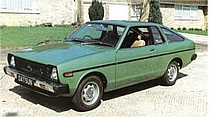
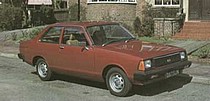
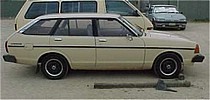
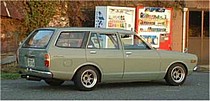
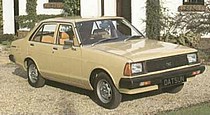

Enjoy finding out about Sunnys,Have a mint 310 Coupe,1500,5 speed.Get so much pleasure out of our 1981 model.